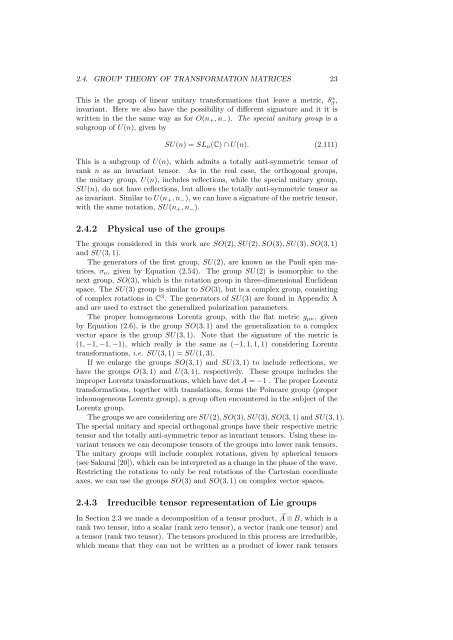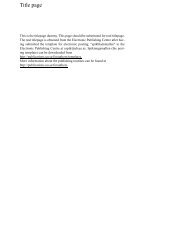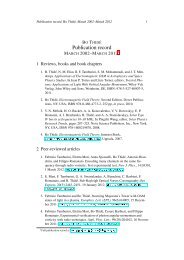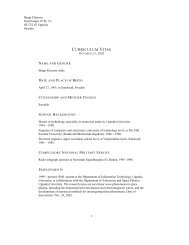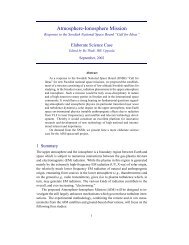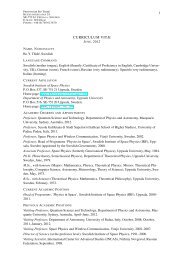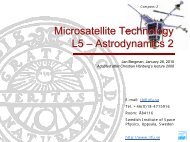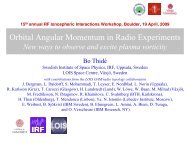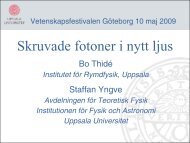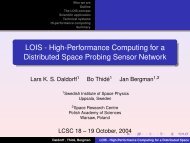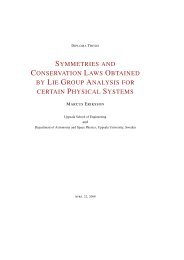Towards a covariant formulation of electromagnetic wave polarization
Towards a covariant formulation of electromagnetic wave polarization
Towards a covariant formulation of electromagnetic wave polarization
You also want an ePaper? Increase the reach of your titles
YUMPU automatically turns print PDFs into web optimized ePapers that Google loves.
2.4. GROUP THEORY OF TRANSFORMATION MATRICES 23<br />
This is the group <strong>of</strong> linear unitary transformations that leave a metric, δ α β ,<br />
invariant. Here we also have the possibility <strong>of</strong> different signature and it it is<br />
written in the the same way as for O(n + , n − ). The special unitary group is a<br />
subgroup <strong>of</strong> U(n), given by<br />
SU(n) = SL n (C) ∩ U(n). (2.111)<br />
This is a subgroup <strong>of</strong> U(n), which admits a totally anti-symmetric tensor <strong>of</strong><br />
rank n as an invariant tensor. As in the real case, the orthogonal groups,<br />
the unitary group, U(n), includes reflections, while the special unitary group,<br />
SU(n), do not have reflections, but allows the totally anti-symmetric tensor as<br />
as invariant. Similar to U(n + , n − ), we can have a signature <strong>of</strong> the metric tensor,<br />
with the same notation, SU(n + , n − ).<br />
2.4.2 Physical use <strong>of</strong> the groups<br />
The groups considered in this work are SO(2), SU(2), SO(3), SU(3), SO(3, 1)<br />
and SU(3, 1).<br />
The generators <strong>of</strong> the first group, SU(2), are known as the Pauli spin matrices,<br />
σ ν , given by Equation (2.54). The group SU(2) is isomorphic to the<br />
next group, SO(3), which is the rotation group in three-dimensional Euclidean<br />
space. The SU(3) group is similar to SO(3), but is a complex group, consisting<br />
<strong>of</strong> complex rotations in C 3 . The generators <strong>of</strong> SU(3) are found in Appendix A<br />
and are used to extract the generalized <strong>polarization</strong> parameters.<br />
The proper homogeneous Lorentz group, with the flat metric g µν , given<br />
by Equation (2.6), is the group SO(3, 1) and the generalization to a complex<br />
vector space is the group SU(3, 1). Note that the signature <strong>of</strong> the metric is<br />
(1, −1, −1, −1), which really is the same as (−1, 1, 1, 1) considering Lorentz<br />
transformations, i.e. SU(3, 1) = SU(1, 3).<br />
If we enlarge the groups SO(3, 1) and SU(3, 1) to include reflections, we<br />
have the groups O(3, 1) and U(3, 1), respectively. These groups includes the<br />
improper Lorentz transformations, which have det A = −1 . The proper Lorentz<br />
transformations, together with translations, forms the Poincare group (proper<br />
inhomogeneous Lorentz group), a group <strong>of</strong>ten encountered in the subject <strong>of</strong> the<br />
Lorentz group.<br />
The groups we are considering are SU(2), SO(3), SU(3), SO(3, 1) and SU(3, 1).<br />
The special unitary and special orthogonal groups have their respective metric<br />
tensor and the totally anti-symmetric tenor as invariant tensors. Using these invariant<br />
tensors we can decompose tensors <strong>of</strong> the groups into lower rank tensors.<br />
The unitary groups will include complex rotations, given by spherical tensors<br />
(see Sakurai [20]), which can be interpreted as a change in the phase <strong>of</strong> the <strong>wave</strong>.<br />
Restricting the rotations to only be real rotations <strong>of</strong> the Cartesian coordinate<br />
axes, we can use the groups SO(3) and SO(3, 1) on complex vector spaces.<br />
2.4.3 Irreducible tensor representation <strong>of</strong> Lie groups<br />
In Section 2.3 we made a decomposition <strong>of</strong> a tensor product, ⃗ A ⊗ B, which is a<br />
rank two tensor, into a scalar (rank zero tensor), a vector (rank one tensor) and<br />
a tensor (rank two tensor). The tensors produced in this process are irreducible,<br />
which means that they can not be written as a product <strong>of</strong> lower rank tensors


